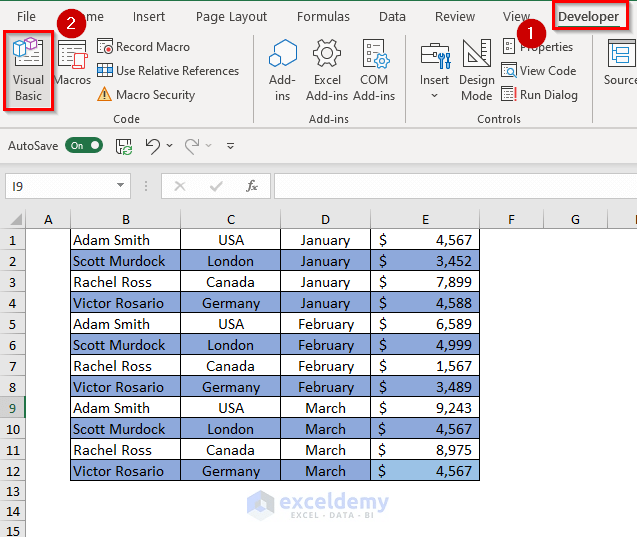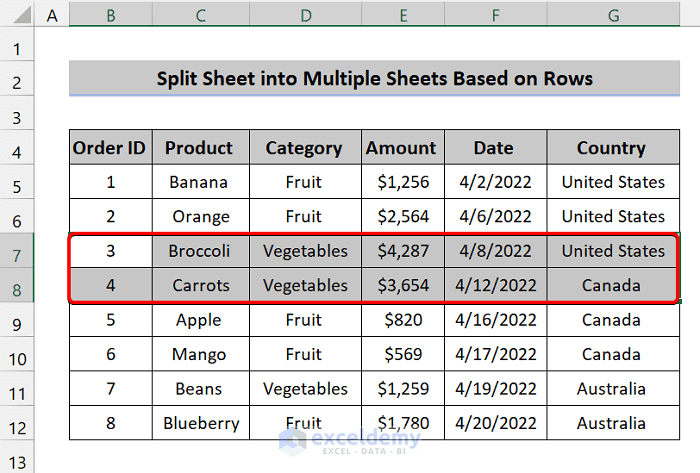5 Ways to Split Excel Rows into Multiple Sheets Easily

Managing data efficiently in Microsoft Excel is crucial for businesses and individuals alike. One common task involves splitting large datasets into smaller, manageable chunks. Here, we'll explore five straightforward methods to split Excel rows into multiple sheets, making data handling and analysis much easier.
Split by Value

Splitting data based on a column’s values is one of the simplest approaches:
- Select your dataset.
- Go to ‘Data’ tab, choose ‘Sort & Filter’, then ‘Sort’ to arrange the column you’ll split by.
- Click ‘Developer’ > ‘Visual Basic’ to open VBA editor.
- Use the following VBA code:
Sub SplitRowsByValue()
Dim ws As Worksheet
Dim newWs As Worksheet
Dim lastRow As Long
Dim criteriaColumn As Range
Dim cell As Range
Dim uniqueValues() As Variant
Dim valueIndex As Long
Dim valuesIndex As Long
Set ws = ActiveSheet
lastRow = ws.Cells(ws.Rows.Count, 1).End(xlUp).Row
Set criteriaColumn = ws.Range("A2:A" & lastRow)
uniqueValues = RemoveDuplicates(criteriaColumn)
For valuesIndex = LBound(uniqueValues) To UBound(uniqueValues)
Set newWs = Worksheets.Add
ws.Range("A1:M1").Copy newWs.Range("A1")
newWs.Name = CStr(uniqueValues(valuesIndex))
valueIndex = 2
For Each cell In criteriaColumn
If CStr(cell.Value) = CStr(uniqueValues(valuesIndex)) Then
cell.EntireRow.Copy newWs.Range("A" & valueIndex)
valueIndex = valueIndex + 1
End If
Next cell
Next valuesIndex
End Sub
Function RemoveDuplicates(ByRef rng As Range) As Variant
Dim dict As Object
Dim cell As Range
Set dict = CreateObject("Scripting.Dictionary")
For Each cell In rng
If Not dict.Exists(cell.Value) Then dict.Add cell.Value, Nothing
Next cell
RemoveDuplicates = dict.Keys
End Function
🔍 Note: Ensure that you have VBA enabled in your Excel settings before using this code.
Split by Fixed Number of Rows

When your data size is known or you need uniform distribution:
- Select the range of cells you wish to split.
- Open the VBA editor.
- Insert the following code:
Sub SplitRowsFixedNumber()
Dim ws As Worksheet
Dim newWs As Worksheet
Dim startRow As Long
Dim lastRow As Long
Dim rowChunkSize As Long
Dim i As Long
Set ws = ActiveSheet
lastRow = ws.Cells(ws.Rows.Count, 1).End(xlUp).Row
rowChunkSize = 1000 ' Adjust as necessary
startRow = 2 'Assuming header row is at 1
For i = startRow To lastRow Step rowChunkSize
Set newWs = Worksheets.Add
ws.Range("A1:M1").Copy newWs.Range("A1")
ws.Range("A" & i & ":M" & i + rowChunkSize - 1).Copy newWs.Range("A2")
newWs.Name = "Sheet" & Format(i, "0000")
Next i
End Sub
Split by Date

If you deal with date-related data, splitting by dates can streamline time-based analysis:
- Sort your data by date.
- Use this VBA code:
Sub SplitRowsByDate()
Dim ws As Worksheet
Dim newWs As Worksheet
Dim lastRow As Long
Dim dateColumn As Range
Dim cell As Range
Dim uniqueDates As Collection
Dim dateCounter As Integer
Dim dateIndex As Integer
Set ws = ActiveSheet
lastRow = ws.Cells(ws.Rows.Count, 1).End(xlUp).Row
Set dateColumn = ws.Range("A2:A" & lastRow)
Set uniqueDates = New Collection
On Error Resume Next
For Each cell In dateColumn
If IsDate(cell.Value) Then
uniqueDates.Add CDate(cell.Value), CStr(cell.Value)
End If
Next cell
On Error GoTo 0
For dateIndex = 1 To uniqueDates.Count
Set newWs = Worksheets.Add
ws.Range("A1:M1").Copy newWs.Range("A1")
newWs.Name = Format(uniqueDates(dateIndex), "yyyy-MM-dd")
dateCounter = 2
For Each cell In dateColumn
If IsDate(cell.Value) And CDate(cell.Value) = uniqueDates(dateIndex) Then
cell.EntireRow.Copy newWs.Range("A" & dateCounter)
dateCounter = dateCounter + 1
End If
Next cell
Next dateIndex
End Sub
Using Power Query

For a more advanced, user-friendly approach, consider Power Query:
- Load your Excel data into Power Query:
- Select any cell within your data range.
- Go to ‘Data’ > ‘From Table/Range’.
- Transform and load the data:
- Add a custom column to categorize the data.
- Group the data by this category.
- Export each group to its own sheet.
Split by Excel Formulas and Filters

Excel’s built-in functionality can also do the trick:
- AutoFilter:
- Filter your data by a specific value or date.
- Copy the filtered data to a new sheet.
- Advanced Filter:
- Use advanced filters to isolate rows based on criteria.
- Copy these filtered rows to new sheets.
Summing up, these methods for splitting Excel rows into multiple sheets cater to various scenarios. Whether you're managing simple or complex datasets, knowing how to split data efficiently can save time and enhance your workflow. From VBA to Power Query, each approach has its unique advantages, providing flexibility for different data structures and user preferences.
Can these methods split data into external workbooks?

+
No, these methods focus on splitting within the current workbook. However, you can export each new sheet as a separate workbook manually if needed.
What if the column I want to split by is not at the top?

+
Most of these methods assume that the column to split by is at the top. You would need to adjust the VBA scripts or use Advanced Filter options to deal with data where the split column is not first.
Can these methods handle very large datasets?

+
Yes, especially VBA and Power Query are optimized for dealing with large datasets, but performance might vary based on your system specifications and Excel’s capacity.



